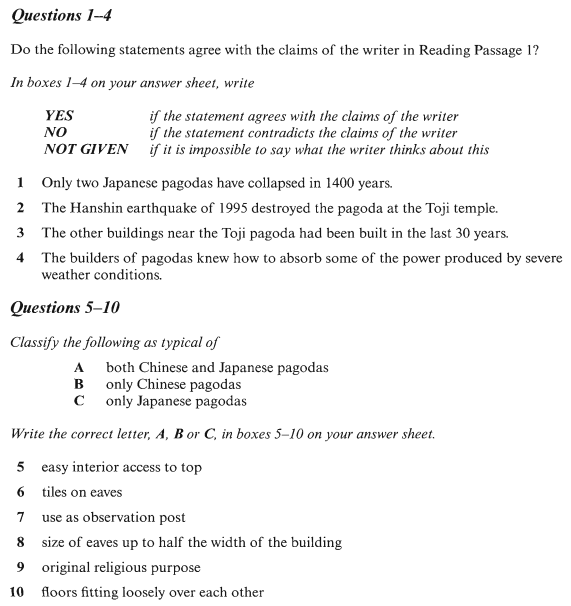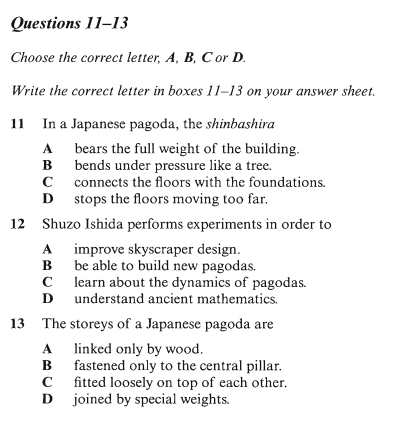剑桥雅思7阅读:Test2雅思阅读PASSAGE 1真题+答案+解析
发布时间:2020-12-01 关键词:剑桥雅思7阅读:Test2雅思阅读PASSAGE 1真题+答案+解析为帮助同学们学习,小编为大家整理了剑桥雅思7阅读:Test2雅思阅读PASSAGE 1真题+答案+解析,希望能够对大家有帮助。关于剑桥雅思的资讯关注新航道北京学校剑桥雅思栏目。
Why pagodas don’t fall down

In a land swept by typhoons and shaken by earthquakes, how have Japan's tallest and seemingly flimsiest old buildings - 500 or so wooden pagodas - remained standing for centuries? Records show that only two have collapsed during the past 1400 years. Those that have disappeared were destroyed by fire as a result of lightning or civil war. The disastrous Hanshin earthquake in 1995 killed 6,400 people, toppled elevated highways, flattened office blocks and devastated the port area of Kobe. Yet it left the magnificent five-storey pagoda at the Toji temple in nearby Kyoto unscathed, though it levelled a number of buildings in the neighbourhood.
Japanese scholars have been mystified for ages about why these tall, slender buildings are so stable. It was only thirty years ago that the building industry felt confident enough to erect office blocks of steel and reinforced concrete that had more than a dozen floors. With its special shock absorbers to dampen the effect of sudden sideways movements from an earthquake, the thirty-six-storey Kasumigaseki building in central Tokyo - Japan's first skyscraper - was considered a masterpiece of modern engineering when it was built in 1968.
Yet in 826, with only pegs and wedges to keep his wooden structure upright, the master builder Kobodaishi had no hesitation in sending his majestic Toji pagoda soaring fifty-five metres into the sky - nearly half as high as the Kasumigaseki skyscraper built some eleven centuries later. Clearly, Japanese carpenters of the day knew a few tricks about allowing a building to sway and settle itself rather than fight nature's forces. But what sort of tricks?
The multi-storey pagoda came to Japan from China in the sixth century. As in China, they were first introduced with Buddhism and were attached to important temples. The Chinese built their pagodas in brick or stone, with inner staircases, and used them in later centuries mainly as watchtowers. When the pagoda reached Japan, however, its architecture was freely adapted to local conditions - they were built less high, typically five rather than nine storeys, made mainly of wood and the staircase was dispensed with because the Japanese pagoda did not have any practical use but became more of an art object. Because of the typhoons that batter Japan in the summer, Japanese builders learned to extend the eaves of buildings further beyond the walls. This prevents rainwater gushing down the walls. Pagodas in China and Korea have nothing like the overhang that is found on pagodas in Japan.
The roof of a Japanese temple building can be made to overhang the sides of the structure by fifty per cent or more of the building's overall width. For the same reason, the builders of Japanese pagodas seem to have further increased their weight by choosing to cover these extended eaves not with the porcelain tiles of many Chinese pagodas but with much heavier earthenware tiles.
But this does not totally explain the great resilience of Japanese pagodas. Is the answer that, like a tall pine tree, the Japanese pagoda - with its massive trunk-like central pillar known as shinbashira - simply flexes and sways during a typhoon or earthquake? For centuries, many thought so. But the answer is not so simple because the startling thing is that the shinbashira actually carries no load at all. In fact, in some pagoda designs, it does not even rest on the ground, but is suspended from the top of the pagoda - hanging loosely down through the middle of the building. The weight of the building is supported entirely by twelve outer and four inner columns.
And what is the role of the shinbashira, the central pillar? The best way to understand the shinbashira's role is to watch a video made by Shuzo Ishida, a structural engineer at Kyoto Institute of Technology. Mr Ishida, known to his students as 'Professor Pagoda' because of his passion to understand the pagoda, has built a series of models and tested them on a 'shake- table' in his laboratory. In short, the shinbashira was acting like an enormous stationary pendulum. The ancient craftsmen, apparently without the assistance of very advanced mathematics, seemed to grasp the principles that were, more than a thousand years later, applied in the construction of Japan's first skyscraper. What those early craftsmen had found by trial and error was that under pressure a pagoda's loose stack of floors could be made to slither to and fro independent of one another. Viewed from the side, the pagoda seemed to be doing a snake dance - with each consecutive floor moving in the opposite direction to its neighbours above and below. The shinbashira, running up through a hole in the centre of the building, constrained individual storeys from moving too far because, after moving a certain distance, they banged into it, transmitting energy away along the column.
Another strange feature of the Japanese pagoda is that, because the building tapers, with each successive floor plan being smaller than the one below, none of the vertical pillars that carry the weight of the building is connected to its corresponding pillar above. In other words, a five- storey pagoda contains not even one pillar that travels right up through the building to carry the structural loads from the top to the bottom. More surprising is the fact that the individual storeys of a Japanese pagoda, unlike their counterparts elsewhere, are not actually connected to each other. They are simply stacked one on top of another like a pile of hats. Interestingly, such a design would not be permitted under current Japanese building regulations.
And the extra-wide eaves? Think of them as a tightrope walker's balancing pole. The bigger the mass at each end of the pole, the easier it is for the tightrope walker to maintain his or her balance. The same holds true for a pagoda. 'With the eaves extending out on all sides like balancing poles,' says Mr Ishida, 'the building responds to even the most powerful jolt of an earthquake with a graceful swaying, never an abrupt shaking.' Here again, Japanese master builders of a thousand years ago anticipated concepts of modern structural engineering.
为什么宝塔不会倒
在一个台风肆虐、地震肆虐的地区,日本、看似最脆弱的古老建筑——500座左右的木制宝塔——是如何屹立不倒几个世纪的呢?记录显示,在过去的1400年里,只有两座火山发生过崩塌。那些消失的都是被闪电或内战所烧毁的。1995年灾难性的阪神大地震造成6400人死亡,高架路倒塌,办公大楼被夷为平地,神户港区被摧毁。然而,尽管它夷平了附近的一些建筑,但京都附近东寺宏伟的五层宝塔却毫发无损。
长期以来,日本学者一直对这些高大细长的建筑为何如此稳定感到困惑。仅仅在30年前,建筑行业才有足够的信心建造了十几层的钢筋混凝土办公楼。位于东京市中心的36层霞关大厦是日本的幢摩天大楼,其特殊的减震器可以减弱地震时突然侧向移动的影响,1968年建成时被认为是现代工程的杰作。
然而,在826年,只有钉子和楔子来保持他的木质结构直立,建筑大师Kobodaishi毫不犹豫地将他宏伟的东寺宝塔高耸入天,高达55米——几乎是11个世纪后建造的Kasumigaseki摩天楼的一半。很明显,当时的日本木匠知道一些让建筑摇摆和稳定的技巧,而不是对抗自然力量。但是是什么样的技巧呢?
这座多层宝塔于六世纪从中国传入日本。和在中国一样,他们最早传入佛教,附属于重要的寺庙。中国人用砖或石头建造塔,里面有楼梯,在后来的几个世纪里主要用作瞭望塔。宝塔到达日本的时候,然而,其架构是自由地适应当地条件,他们建造了那么高,通常5而不是9层,主要是木材和楼梯是摒弃因为日本宝塔没有任何实际使用但变得更像一个艺术对象。由于夏天袭击日本的台风,日本的建筑商学会了把建筑物的屋檐延伸到墙外。这样可以防止雨水顺着墙涌下去。中国和韩国的宝塔没有像日本的宝塔那样的悬垂。
日本寺庙建筑的屋顶可以使建筑的两侧伸出50%或的建筑宽度。出于同样的原因,日本宝塔的建造者似乎进一步增加了他们的重量,他们没有像中国宝塔那样用瓷片覆盖这些延伸的屋檐,而是用了更重的陶器瓦。
但这并不能完全解释日本宝塔的巨大韧性。答案是,像一棵高大的松树一样,日本宝塔——其巨大的树干状中央柱被称为“心柱”——只是在台风或地震中弯曲和摇晃吗?几个世纪以来,许多人都这么认为。但答案并不那么简单,因为令人吃惊的是,心柱实际上根本没有负载。事实上,在一些宝塔的设计中,它甚至没有停在地面上,而是悬挂在宝塔的顶部——从建筑的中间松散地垂下来。建筑的重量完全由十二根外柱和四根内柱支撑。
中间的支柱心柱的作用是什么?要了解新bashira的作用,的方法是看一段由京都理工学院结构工程师石田修三制作的视频。石田先生,由于他对理解宝塔的热情,被他的学生称为“宝塔”。他建造了一系列模型,并在他的实验室的“振动台”上进行了测试。简而言之,心柱就像一个巨大的静止的钟摆。古代的工匠,显然没有先进的数学的帮助,似乎掌握了原理,并应用于一千多年后,日本的座摩天大楼的建设。这些早期的工匠通过反复试验发现,在压力作用下,宝塔松散的楼层可以相互独立地来回滑动。从侧面看,宝塔似乎在跳蛇舞——连续的每一层楼都在上下方向相反的方向移动。“心柱”穿过建筑中心的一个洞向上延伸,它限制了每层楼的移动距离,因为移动距离后,它们就会撞到心柱上,沿着柱子传递能量。日本宝塔的另一个奇怪的特点是,由于建筑呈锥形,


READING PASSAGE 1
文章结构
体 裁:议论+说明文
主 题:古代日本塔的简介及其有别与其他塔型建筑的几个基本特征
段落概括
段举例子说明古代日本塔是多么的坚固。
第二段1968年特殊减震器的发明是日本建筑史上的杰作。
第三段古代日本塔的高度。
第四段古代日本塔建造过程中的主要窍门。
第五段古代日本塔的屋顶建筑的主要材料。
第六段在设计环节上shinbashira自身并不受力,建筑的重量完全由外面的12根柱子和里面的4根柱子承担。
第七段Shinbashira这个中间的柱子到底其作用何在。
第八段古代日本塔在其建筑过程中的另一个奇怪特点。
第九段日本塔延长的屋檐的实际作用。




